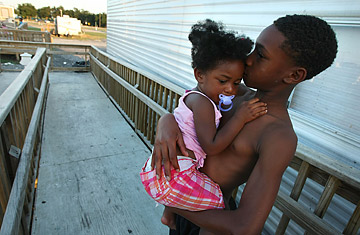
Adrian Cross, 10, holds his 18-month-old sister Kailah Smith outside their parents' FEMA trailer just before the family moved to an apartment in Port Sulphur, La.
(2 of 2)
Although the study reported that behavioral problems among the study sample had decreased overall over time — with nearly half of the children showing no lasting signs of stress — more than 25% of the younger kids were still exhibiting significant symptoms of PTSD and depression, such as feeling sad or nervous and having trouble sleeping or concentrating.
It may be that older children had more emotional resources to call on, which made it easier for them to bounce back. "Whereas younger children are more dependent on their caretakers, adolescents can turn to their friends or others in the community," says Joy Osofsky, a child psychologist at LSU who co-authored the study. Indeed, the children who fared best post-Katrina were those whose schools were quickly rebuilt and who had supportive relationships, both at home and at school.
Despite the age advantage, girls of any age were twice as likely as boys to have problems adapting after the disaster — an effect reported by both Osofsky's current research as well as several prior studies. One explanation, put forth by the second Katrina study in Child Development, is that girls may simply be more expressive of their feelings of stress than boys are, even if boys have the same emotions. In the study, which analyzed saliva samples from 62 boys and girls between the ages of 12 and 19 who had been relocated to camps after the hurricane, researchers found no significant difference in levels of salivary cortisol, a hormone associated with stress, between the genders.
Jacob Vigil, a psychologist at the University of New Mexico and lead author of the study, hypothesizes that the differences in the way boys and girls react to trauma may be due to social conditioning rather than actual physiological effects. It may also be possible that similar levels of stress hormones affect males and females differently.
Past studies have shown that PTSD is more likely to manifest itself in boys as concentration and behavioral problems, while girls tend to exhibit emotional reactions like guilt and anxiety. "Girls tend to internalize their problems, whereas boys are more likely to act out," says Gershoff. Other common symptoms of the disorder may include nightmares, upsetting thoughts about the past trauma, avoidance of reminders of the event and persistent worrying about more bad things happening.
Although there was no significant difference in the levels of cortisol in boys and girls in Vigil's study, he did note that cortisol levels in the traumatized population of kids living in relocation camps were lower on average than those of a control group. That suggests the Katrina survivors had lived with constant stress for so long that they had become almost inured to its effect — they became less reactive to relatively minor, day-to-day stressors. "It's like a rubber band that gets stretched too much. Folks who are not reactive to stress seem to have more stress in their life," notes Vigil. Low cortisol levels have been associated with depression in adults, and while depression is a separate condition from PTSD, they share many of the same symptoms such as trouble sleeping and concentrating.
Child advocates say that one way to minimize long-term PTSD in kids is to provide them with the same level of psychological support that is regularly offered to adults. "It is important that kids have access to mental-health services right after a disaster," says Gershoff. "We can't just assume that kids are going to get over it. They need someone who can help them cope," especially when their parents can't.
